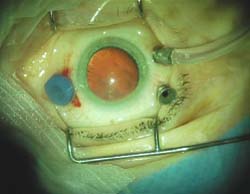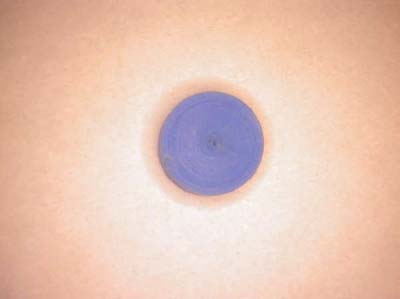19

20-Gauge Sutureless Vitrectomy
Carl Claes  Anna Paula R. Lafeta
Anna Paula R. Lafeta
INTRODUCTION
Sutureless pars plana vitrectomy was first proposed by Chen (1), and it was based on 20-gauge (20G) self-sealing scleral tunnels. Many complications were reported and other authors have described modifications for this technique to avoid problems such as wound leakage, dehiscence, hemorrhage, incarceration of vitreous and/or retina, retinal tears, and dialyses (2–7).
The use of trocars for sutureless vitrectomy was first described by Fugii et al. (8, 9). A scleral perpendicular 25-gauge incision was used, and they suggested that the holes would be closed because they were small and the conjunctiva would also cover them, serving as a protection. However, in minimal surgery, the closure of the sclerotomies is essentially made by the peripheral vitreous, possibly increasing the risk of incarceration and secondary retinal detachment. If this peripheral vitreous were removed in order to avoid this complication, it would increase the possibility of wound leakage and hypotony.
Although the 25-gauge system seemed to be very attractive, reducing surgical time, minimizing trauma, and hastening postoperative recovery, some problems such as flexibility and fragility (10) of the instruments, low infusion and aspiration rates (8) and, of course, higher costs, have limited its use. Since then, many attempts have been made to improve sutureless vitreoretinal surgery.
Eckardt (11) presented, as an alternative to the 25-gauge, a new method using a 23-gauge system. He has used a 30 to 40 degree tunnel incision made with a stiletto and inserted the cannulas using a blunt inserter. This system offers the advantages of a sutureless surgery, but it requires a completely different set of instruments. These instruments are flexible, increasing surgery costs and limiting indications. To avoid the leakage mentioned before in the 25-gauge surgeries, Lópes-Guajardo (12) proposed that the sclerotomies should be done in the same way Eckardt (4) described for 23-gauge surgery, creating scleral tunnels with displacement of the conjunctiva.
We introduced a new 20G transconjunctival trocar system (Dutch Ophthalmic Research Corporation [DORC], Zuidland, Holland) that allows the use of the conventional 20G vitrectomy in sutureless surgeries. It is analogous to the 23-gauge approach. A tangential tunnel is made with a bent stiletto, and the trocars are introduced with a blunt inserter in a two-step technique.
METHODS
The first generation trocars were designed 3 years ago. A set (Fig. 19-1) includes: one infusion inserter (measures 11.5 mm), one infusion trocar (measures 8.5 mm with a 4.0 mm intraocular extension), and two blunt trocar-inserters (measuring 10.0 mm with a 4.0 mm intraocular extension). The blunt trocar-inserters are used to place the 6.5 mm trocars. The external diameter for the infusion and trocars is 1.0 mm, and the internal diameter is 0.9 mm. However, the intense leakage of infusion fluids through gaping 20G ports caused hypotony at various moments during the surgery. To solve this problem, different types of disposable valves were developed (Fig. 19-2). They keep the eye sealed after retraction of the instruments and allow the surgeon to have complete control of the intraocular pressure. Also they reduce the consumption of infusion fluids. The valves fit the distal trocar tip and are easily removable (Figs. 19-3 and Figs. 19-4). Indentation can be executed without difficulty and the periphery is easily accessible. The trocars protect the entry sites from erosion, and plugs are not needed when using this system.

Figure 19-1. A complete set.
The procedure is initiated using a 20-gauge bent stiletto (45-degree angle; 0.9 mm; Blumenthal; BD Visitec) that is inserted at a 10-degree angle through the conjunctiva, without displacement (Fig. 19-5), to create a 3.5 mm scleral tunnel (Fig. 19-6). Incisions are radially made at 3 mm from the limbus and tunnels are made limbus-parallel (Figs. 19-5 and Figs. 19-6). The infusion trocar is first placed into the inferotemporal tunnel (Fig. 19-7), and trocars are placed at the superior quadrants (Fig. 19-8). The two-step procedure is thus characterized by using a stiletto to create tunnels followed by trocar placement. It is felt to be relatively atraumatic and is preferred. This approach creates better sclerotomy configurations and is considered decisive for good wound closure at the end of the procedure.

Figure 19-2. Valve.
Stay updated, free articles. Join our Telegram channel

Full access? Get Clinical Tree


